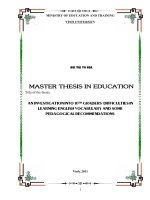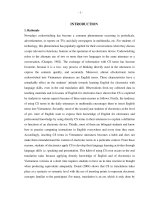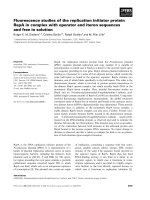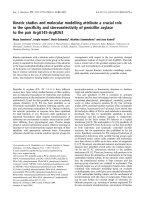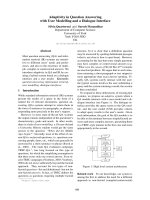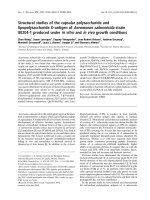Studies in filter cake characterisation and modelling
Bạn đang xem bản rút gọn của tài liệu. Xem và tải ngay bản đầy đủ của tài liệu tại đây (1.79 MB, 194 trang )
STUDIES IN FILTER CAKE CHARACTERISATION
AND MODELLING
TEOH SOO KHEAN
(B. Eng., Univ. Malaya; M. Eng., NUS)
A THESIS SUBMITTED
FOR THE DEGREE OF DOCTOR OF PHILOSOPHY
DEPARTMENT OF CHEMICAL &
ENVIRONMENTAL ENGINEERING
NATIONAL UNIVERSITY OF SINGAPORE
2003
Dedicated to my lovely son, Chan Herng,
Chan Herng,Chan Herng,
Chan Herng,
My loving husband, Teik Lim
Teik LimTeik Lim
Teik Lim
And my dearest Parents
ParentsParents
Parents
Constantly loving
Always understanding
i
ACKNOWLEDGEMENTS
First of all, I wish to thank my academic supervisors, Associate Professor Tan
Reginald B. H. and Professor Tien Chi for their invaluable guidance, advice and help
throughout the course of this research study. And, my sincere gratitude to the National
University of Singapore (NUS) and the National Science and Technology Board
(NSTB) for funding this research project.
I also would like to extend my thanks to the Head of Department, Professor
Neoh K. G. and all the staff members in the Department of Chemical and
Environmental Engineering, National University of Singapore. Without their kind and
helpful support, I would not be able to carry out my work smoothly and in good order.
And, my special thanks to Mr. Boey K. H., the Senior Lab Technologist from Lab
E4A-07 where I used to work in, Mr. Ng K. P. from Workshop 2, Mdm. Teo A. P.,
Mdm. Chiang H. J., Mdm. Koh, Mdm. Tay, Ms. Ng, Mdm. Siva, Mdm. Sutini, Ms.
Goh S. P. and many others. Also, I wish to thank Mr. Bernd R. and Ms. Er Y. S. for
providing the computer program on Filtration Model proposed by Stamatakis and
Tien.
To my son, my husband and my family, I am most grateful for their love,
patience, encouragement, and support that enable me to complete this thesis. Last but
not least, in the memory of late Dr. He Daxin, I wish to take this opportunity to
express my sincere gratitude for his kind guidance, advice and help at the initial stage
of this course. May he rest in peace forever.
*** MANY THANKS TO ALL OF YOU ***
ii
TABLE OF CONTENTS
Page
ACKNOWLEDGEMENT i
TABLE OF CONTENTS ii
SUMMARY v
LIST OF TABLES vii
LIST OF FIGURES ix
NOTATION xviii
CHAPTER 1 INTRODUCTION
1.1 Filtration and Solid-liquid Separation 1
1.2 Classification of Filtration 2
1.3 Application of Filtration 4
1.4 Filter Cake Analysis 5
1.5 Scope and Objectives 7
CHAPTER 2 LITERATURE REVIEW
2.1 Cake Filtration Theory 13
2.1.1 Fluid Flow in Porous Media 13
2.1.2 Filter Cake Permeability and Porosity 16
2.1.3 Solid Compressive Pressure,
s
p
and Hydraulic (Pore Liquid)
Pressure,
l
p
18
2.1.4 Empirical Constitutive Equations Relating Local Cake
Properties and Compressive Pressure 21
2.2 Analysis and Modelling of Cake Filtration
(cake formation and growth) 26
2.2.1 Determination of Empirical Data for Filter Cake Analysis 31
2.2.1.1 The Compression-Permeability Cell 32
2.2.1.2 Filtration Experiment 37
CHAPTER 3 DEVELOPMENT OF A NEW MULTIFUNCTION TEST CELL
3.1 Introduction 46
iii
3.2 Description of the Multifunction Test Cell 47
3.2.1 Multifunction Test Cell used as a C-P Cell 48
3.2.2 Multifunction Test Cell used as a Filtration Unit 50
3.3 Experiments 51
3.3.1 Combined Resistance of Filter Medium and Porous Support Plate 51
3.3.2 Filter Cake Compression and Permeation Test 52
3.3.3 Filtration Test 53
3.4 Results and Discussion 53
3.4.1 Combined Resistance of Filter Medium and Porous Support Plate 53
3.4.2 Correction of Applied Pressure in C-P Cell 54
3.4.3 Filter Cake Compressibility and Permeability 55
3.4.4 Constant Pressure Filtration 56
3.4.5 Correlation of C-P and Filtration Data 60
3.5 Concluding Remarks 62
CHAPTER 4 EFFECT OF THE RELATIONSHIP BETWEEN PORE LIQUID
PRESSURE AND CAKE COMPRESSIVE STRESS ON CAKE FILTRATION
ANALYSIS
4.1 Introduction 91
4.2 Explicit Expressions of
l
p
92
4.3 Re-derivation of the Parabolic Law for Constant-Pressure Filtration 94
4.4. Experiments 100
4.5 Results and Discussions 100
4.5.1 C-P Cell and Filtration Results 100
4.5.2 Assessing the Effect of the
sl
pp
−
Relationships 101
4.5.3 Correspondence between the Specific Cake Resistance
determined from Filtration Data and C-P-cell Measurement Results 102
4.5.4 Correlation of
sl
pp
−
Relationship with Cake Characteristics 104
4.6 Concluding Remarks 105
CHAPTER 5 A NEW PROCEDURE OF INTERPRETING FILTRATION DATA
5.1 Introduction 115
iv
5.2 Initial Filtration Period 117
5.2.1 Analysis of Initial Filtration Period 118
5.3 Determination of Cake Characteristics from Filtration Experimental
Data 120
5.3.1 Effect of Medium Resistance 123
5.3.2 New Procedure for Interpreting Filtration Data 126
5.4 Concluding Remarks 129
CHAPTER 6 CONCLUSIONS AND RECOMMENDATIONS FOR 149
FUTURE WORK
REFERENCES 155
APPENDIX A PROPERTIES OF MATERIALS 164
APPENDIX B EXAMPLES TO DEMONSTRATE THE NEW
PROCEDURE OF INTERPRETING FILTRATION
DATA 168
APPENDIX C LIST OF PUBLICATIONS 172
v
SUMMARY
The objective of this research is to perform some studies on cake filtration
process using a newly developed multifunction test cell. Cake filtration is an important
process in solid-liquid separation. The average properties of filter cake could be
obtained from the relationship between local cake properties and effective
compressive pressure, which has been commonly determined using a Compression-
permeability (C-P) cell. The filtration characterization results in previous studies were
compared based on data obtained from two different units, i.e. a C-P cell and a
separate filtration unit. This method leads to uncertainties due to irreproducibility of
cake surface and cell wall interface conditions.
The new multifunction test cell was designed to serve as a Compression-
Permeability (C-P) cell, as well as a variable-volume filtration chamber to enable a
direct comparison and correlation between the data. It was modified from a universal
tensile testing machine and equipped with computerised testing system and data
acquisition facility. The effect of sidewall friction could be accounted for from the
measurement of lower load cell. The experimental results obtained from this new
multifunction test cell were observed to be comparable to the literature data and within
tolerable reproducibility. It is able to predict the actual filtration process from the C-P
test data of cake materials with various compressibility (CaCO
3
, Kaolin, TiO
2
and
Kromasil) within pressure range of 100 to 800 kPa.
The relationship between pore liquid pressure and solid compressive pressure
on the application of C-P cell data for the prediction of cake filtration performance
was also investigated. The relationship that involved cake porosity was found to
predict the filtration performance closer to the filtration experimental results than the
vi
commonly employed equation ( 0
=+
sl
dpdp
). For the four material systems in study,
equation 0)1(
=+−
sls
dpdp
ε
shows a better agreement for cake with compressibility
ranges from
=
n
0.32-0.51, whereas equation 0)1(
=+−
ssls
dpdp
εε
gives a better
agreement for material with higher compressibility (
=
n
0.85). This speculated the
need of incorporating cake porosity in
l
p
–
s
p
relationship and the effect of cake
compressibility on this relationship.
The effect of initial filtration period due to medium resistance on the non-
parabolic behaviour of
tv
−
relationship was investigated. In view of the steep
reduction in filtration velocity, the initial period may be defined as up to the time when
filtration velocity drops to half of its initial value. With that, the plot of
v
t
versus
v
could be approximately sectionalized into two segments. The conventional approach
only enables the determination of an average specific cake resistance from the slope of
the entire
v
t
vs.
v
plot, which is approximated to be linear, corresponding to a
compressive stress equals to the operating pressure, and the average specific cake
resistance and wet cake to dry cake mass ratio are assumed to be constant.
Recognizing the effect of initial filtration period and variation of
m
and
[]
m
s
p
av
α
, a
new method of analysis was developed to interpret filtration data as functions of time
to generate information on filter cake characteristics. Average specific cake resistance
over a range of compressive stress could be obtained from a single filtration
experiment.
vii
LIST OF TABLES
Page
Table 3.1 Experimental Conditions Used in Filtration Experiments 86
Table 3.2 Data of L vs. t from Filtration Experiments 87
Table 3.3 Data of
s
p ,
s
ε
,
α
and
k
from C-P Cell Measurement for CaCO
3
-H
2
O,
Kaolin-H
2
O, TiO
2
-H
2
O and Kromasil-H
2
O System 88
Table 3.4 Constitutive Parameters for CaCO
3
-H
2
O, Kaolin-H
2
O, TiO
2
-H
2
O and
Kromasil-H
2
O System 90
Table 4.1 Values of
'
f
−
for the Four
sl
pp
−
Relationships based on the
Constitutive Parameters from Table 3.4 for CaCO
3
-H
2
O, Kaolin-H
2
O,
TiO
2
-H
2
O and Kromasil-H
2
O System 114
Table 5.1(a) Initial Filtration Velocity and the Estimated Duration of Initial Period
for 2% CaCO
3
-H
2
O Systems with 2 Filter Papers and 20 mm Cake
Thickness 146
Table 5.1(b) Initial Filtration Velocity and the Estimated Duration of Initial Period
for 5% Kaolin-H
2
O Systems with 2 Filter Papers and 20 mm Cake
Thickness 147
Table 5.2 Values of
m
R (m
-1
) determined from Different Methods for Two No.
of Whatman # 1 Filter Papers 148
Table A1 Properties of Calcium Carbonate 164
Table A2 Properties of Kaolin 165
Table A3 Properties of Titanium Dioxide 166
Table A4 Properties of Kromasil 167
viii
Table B1 Data of t , v from Filtration Experiment and
dt
dv
,
m
p
∆
,
c
p
∆
,
L
,
s
ε
, m
and
m
s
pav
][
α
determined using the New Method for 2% CaCO
3
-H
2
O
System at kPaP
o
800
=
,
mmL 20
=
with 2 Filter Papers 170
Table B2 Data of t , v from Filtration Experiment and
dt
dv
,
m
p
∆
,
c
p
∆
, L
,
s
ε
, m
and
m
s
pav
][
α
determined using the New Method for 5% Kaolin-H
2
O
System at kPaP
o
800
=
,
mmL 20
=
with 2 Filter Papers 171
ix
LIST OF FIGURES
Page
Figure 1.1 Stages in Solid-liquid Separation (Tiller et al., 1987) 10
Figure 1.2 Deep Bed Filtration versus Cake Filtration (Svarovsky, 1981) 11
Figure 1.3 Classification of Pressure Filtration based on Pumping Mechanism
(Tiller et al., 1987) 12
Figure 2.1 Compressive Force due to Frictional Drag in a Filter Cake (Tiller, 1953) 41
Figure 2.2 Correlation of the ratio
c
s
p
p
∆
with Porosity (Willis et al., 1974) 42
Figure 2.3 Variation of Filtration Resistance and Wet Cake to Dry Cake Mass
Ratio with Time in Constant Pressure Filtration (Tiller and Cooper, 1960) 43
Figure 2.4 A Typical Compression-Permeability Cell 44
Figure 2.5 Schematic Diagram of Orifice Filter and the Plot of
dv
dt
versus
v
(Murase et al., 1987) 45
Figure 3.1 Schematic Diagram of the New Multifunction Test Cell Set-up 65
Figure 3.2 Multifunction Test Cell used as a C-P Cell 66
Figure 3.3 Multifunction Test Cell used as a Filtration Cell 67
Figure 3.4 Filter Septum Resistance vs. Applied Pressure at Various Number of
Filter Papers 68
Figure 3.5 Cumulative Filtrate Volume vs. Time for Filter Septum at Various
Compressive Pressure 68
Figure 3.6 Transmitted Pressure vs. Applied Pressure for 50g CaCO
3
in De-ionized
Water 69
x
Figure 3.7 Variation of Cake Thickness with Time in the Compression of 50g
CaCO
3
in De-ionized Water at
s
p
= 820 kPa 69
Figure 3.8(a) Specific Cake Resistance vs. Solid Compressive Pressure for CaCO
3
-H
2
O
system in C-P Test 70
Figure 3.8(b) Cake Porosity vs. Solid Compressive Pressure for CaCO
3
-H
2
O system
in C-P Test 70
Figure 3.9(a) Cake Permeability vs. Cake Porosity for CaCO
3
-H
2
O system in C-P Test 71
Figure 3.9(b) Cake Permeability vs. Cake Porosity for Kaolin-H
2
O system in C-P Test 71
Figure 3.9(c) Cake Permeability vs. Cake Porosity for TiO
2
-H
2
O system in C-P Test 72
Figure 3.9(d) Cake Permeability vs. Cake Porosity for Kromasil-H
2
O system in
C-P Test 72
Figure 3.10(a) Cumulative Filtrate Volume per Unit Area vs. Filtration Time for 2%
CaCO
3
-H
2
O Suspension with Preset Cake Thickness = 20 mm and under
Filtration Pressure of 800 kPa 73
Figure 3.10(b)
v
t
vs.
v
for CaCO
3
-H
2
O Suspension with Preset Cake Height = 20 mm
and under Filtration Pressure of 8 x 10
5
Pa 73
Figure 3.11(a) Cake Thickness vs. Filtration Time for 2% CaCO
3
-H
2
O Suspension
at Various Filtration Pressure 74
Figure 3.11(b) Cake Thickness vs. Filtration Time for 5% Kaolin-H
2
O Suspension
at Various Filtration Pressure 74
Figure 3.12(a) Average Specific Cake Resistance vs. Cake Thickness for CaCO
3
-H
2
O
system in Filtration Test 75
Figure 3.12(b) Average Specific Cake Resistance vs. Cake Thickness for Kaolin-H
2
O
system in Filtration Test 75
xi
Figure 3.13(a) Cumulative Filtrate Volume per Unit Area vs. Filtration Time for 2%
CaCO
3
-H
2
O Suspension with Various Cake Thickness Setting and
Filtration Pressure 76
Figure 3.13(b) Cumulative Filtrate Volume per Unit Area vs. Filtration Time for 5%
Kaolin-H
2
O Suspension with Various Cake Thickness Setting
and Filtration Pressure 76
Figure 3.14(a) Cumulative Filtrate Volume per Unit Area vs. Filtration Time for 2%
CaCO
3
-H
2
O Suspension at Filtration Pressure of 100 kPa with Various
Cake Thickness Setting for the first 10mm of Cake Thickness 77
Figure 3.14(b) Cumulative Filtrate Volume per Unit Area vs. Filtration Time for 2%
CaCO
3
-H
2
O Suspension at Filtration Pressure of 500 kPa with Various
Cake Thickness Setting for the first 10mm of Cake Thickness 77
Figure 3.14(c) Cumulative Filtrate Volume per Unit Area vs. Filtration Time for 2%
CaCO
3
-H
2
O Suspension at Filtration Pressure of 800 kPa with Various
Cake Thickness Setting for the first 10mm of Cake Thickness 78
Figure 3.15 Wet Cake to Dry Cake Mass Ratio vs. Filtration Time for CaCO
3
-H
2
O
System at Different Filtration Pressure 78
Figure 3.16(a) Average Specific Cake Resistance vs. Filtration Pressure for CaCO
3
-H
2
O
System in Filtration Test 79
Figure 3.16(b) Average Cake Porosity vs. Filtration Pressure for CaCO
3
-H
2
O System in
Filtration Test 79
Figure 3.17(a) Specific Cake Resistance vs. Compressive Pressure from C-P Test
for CaCO
3
-H
2
O, Kaolin-H
2
O, TiO2- H
2
O and Kromasil- H
2
O System 80
Figure 3.17(b) Cake Porosity vs. Compressive Pressure from C-P Test for CaCO
3
-H
2
O,
Kaolin-H
2
O, TiO2- H
2
O and Kromasil- H
2
O System 80
xii
Figure 3.18(a) Comparisons of Average Specific Cake Resistance for CaCO
3
-H
2
O
System between Filtration Test and Predictions from C-P Test 81
Figure 3.18(b) Comparisons of Average Specific Cake Resistance for Kaolin-H
2
O
System between Filtration Test and Predictions from C-P Test 81
Figure 3.18(c) Comparisons of Average Specific Cake Resistance for TiO
2
-H
2
O
System between Filtration Test and Predictions from C-P Test 82
Figure 3.18(d) Comparisons of Average Specific Cake Resistance for Kromasil-H
2
O
System between Filtration Test and Predictions from C-P Test 82
Figure 3.19(a) Comparisons of Average Cake Porosity for CaCO
3
-H
2
O System between
Filtration Test and Predictions from C-P Test 83
Figure 3.19(b) Comparisons of Average Cake Porosity for Kaolin-H
2
O System between
Filtration Test and Predictions from C-P Test 83
Figure 3.19(c) Comparisons of Average Cake Porosity for TiO
2
-H
2
O System between
Filtration Test and Predictions from C-P Test 84
Figure 3.19(d) Comparisons of Average Cake Porosity for Kromasil-H
2
O System
between Filtration Test and Predictions from C-P Test 84
Figure 3.20 Comparisons of Filtrate Volume vs. Time for CaCO
3
-H
2
O Slurry
between Filtration Test, Simulation from Stamatakis and Tien and
Conventional Filtration Theory: Equations 2.51 and 2.53 85
Figure 3.21 Comparisons of Cake Thickness vs. Time for CaCO
3
-H
2
O Slurry
between Filtration Test, Simulation from Stamatakis and Tien and
Conventional Filtration Theory: Equations 2.51 and 2.53 85
Figure 4.1 Representation of One Dimensional Cake Filtration 107
Figure 4.2(a) Results of
l
p
versus
s
p
for CaCO
3
Filter Cakes according to
Cases 1 to 4 at
o
P
= 2 x 10
5
Pa and 7 x 10
5
Pa 108
xiii
Figure 4.2(b) Results of
l
p
versus
s
p
for Kaolin
Filter Cakes according to
Cases 1 to 4 at
o
P
= 2 x 10
5
Pa and 7 x 10
5
Pa 108
Figure 4.2(c) Results of
l
p
versus
s
p
for TiO
2
Filter Cakes according to
Cases 1 to 4 at
o
P
= 2 x 10
5
Pa and 7 x 10
5
Pa 109
Figure 4.2(d) Results of
l
p
versus
s
p
for Kromasil
Filter Cakes according to
Cases 1 to 4 at
o
P
= 2 x 10
5
Pa and 7 x 10
5
Pa 109
Figure 4.3(a) Results of
m
s
p
versus
o
P
for CaCO
3
Filter Cakes according to
Case 1 to Case 4 110
Figure 4.3(b) Results of
m
s
p
versus
o
P
for Kaolin
Filter Cakes according to
Case 1 to Case 4 110
Figure 4.3(c) Results of
m
s
p
versus
o
P
for TiO
2
Filter Cakes according to
Case 1 to Case 4 111
Figure 4.3(d) Results of
m
s
p
versus
o
P
for Kromasil Filter Cakes according to
Case 1 to Case 4 111
Figure 4.4(a) Comparison of Experimental Determined
av
α
and Estimated Values based
on Different
sl
pp
− Relationships for CaCO
3
Cake 112
Figure 4.4(b) Comparison of Experimental Determined
av
α
and Estimated Values based
on Different
sl
pp
− Relationships for Kaolin Cake 112
Figure 4.4(c) Comparison of Experimental Determined
av
α
and Estimated Values based
on Different
sl
pp
− Relationships for TiO
2
Cake 113
Figure 4.4(d) Comparison of Experimental Determined
av
α
and Estimated Values based
on Different
sl
pp
− Relationships for Kromasil Cake 113
xiv
Figure 5.1
v
t
vs.
v
for Filtration of 2% CaCO
3
-H
2
O System at 100 kPa with
pre-set Cake Thickness of 10mm and Various Medium Resistances 132
Figure 5.2(a)
v
t
vs.
v
for Filtration of 2% CaCO
3
-H
2
O System using 2 Filter
Papers with pre-set Cake Thickness of 20mm and Filtration Pressure
of 200 and 800 kPa 133
Figure 5.2(b)
v
t
vs.
v
for Filtration of 5% Kaolin-H
2
O System using 2 Filter
Papers with pre-set Cake Thickness of 20mm and Filtration Pressure
of 200 and 800 kPa 133
Figure 5.3(a) Filtration Velocity vs. Time for Filtration of 2% CaCO
3
-H
2
O System
at Pre-set Cake Thickness of 20mm with 2 Filter Papers 134
Figure 5.3(b) Filtration Velocity vs. Time for Filtration of 5% Kaolin-H
2
O System
at Pre-set Cake Thickness of 20mm with 2 Filter Papers 134
Figure 5.4(a) Sectionalized of
v
t
vs.
v
Plot for Filtration of 2% CaCO
3
-H
2
O System
at pre-set Cake Thickness of 20mm with 2 Filter Papers 135
Figure 5.4(b) Sectionalized of
v
t
vs.
v
Plot for Filtration of 5% Kaolin-H
2
O System
at pre-set Cake Thickness of 20mm with 2 Filter Papers 135
Figure 5.5(a) Comparisons of
m
p
∆ and
c
p
∆ vs.
t
determined from
0
,
=
t
dt
dv
m
R
and
latterm
R
,
for Filtration of 2% CaCO
3
-H
2
O System using 2 Filter Papers
with pre-set Cake Thickness of 20mm and Filtration Pressure of
800 kPa 136
Figure 5.5(b) Comparisons of
m
p
∆ and
c
p
∆ vs.
t
determined from
0
,
=
t
dt
dv
m
R
and
latterm
R
,
for Filtration of 5% Kaolin-H
2
O System using 2 Filter Papers
with pre-set Cake Thickness of 20mm and Filtration Pressure of
xv
800 kPa 136
Figure 5.6(a) Comparisons of Average Specific Cake Resistance vs.
c
p
∆ determined
from
0
,
=
t
dt
dv
m
R
and
latterm
R
,
for Filtration of 2% CaCO
3
-H
2
O System
using 2 Filter Papers with pre-set Cake Thickness of 20mm and
Filtration Pressure of 300 kPa 137
Figure 5.6(b) Comparisons of Average Specific Cake Resistance vs.
c
p
∆ determined
from
0
,
=
t
dt
dv
m
R
and
latterm
R
,
for Filtration of 2% CaCO
3
-H
2
O System
using 2 Filter Papers with pre-set Cake Thickness of 20mm and
Filtration Pressure of 800 kPa 137
Figure 5.7(a) Comparisons of Average Specific Cake Resistance vs.
c
p
∆ determined
from
0
,
=
t
dt
dv
m
R
and
latterm
R
,
for Filtration of 5% Kaolin-H
2
O System
using 2 Filter Papers with pre-set Cake Thickness of 20mm and
Filtration Pressure of 300 kPa 138
Figure 5.7(b) Comparisons of Average Specific Cake Resistance vs.
c
p
∆ determined
from
0
,
=
t
dt
dv
m
R
and
latterm
R
,
for Filtration of 5% Kaolin-H
2
O System
using 2 Filter Papers with pre-set Cake Thickness of 20mm and
Filtration Pressure of 800 kPa 138
Figure 5.8(a) Cake Thickness vs. Filtration Time for CaCO
3
Cake at Various
Filtration Pressures and Fitting with Equation 5.4 139
Figure 5.8(b) Cake Thickness vs. Filtration Time for Kaolin Cake at Various
Filtration Pressures and Fitting with Equation 5.4 139
Figure 5.9(a) Variation of
s
ε
with
t
for CaCO
3
Cake at Filtration Pressure of
800 kPa 140
Figure 5.9(b) Variation of
s
ε
with
t
for Kaolin Cake at Filtration Pressure of
xvi
800 kPa 140
Figure 5.10(a) Variation of
m
with
t
for CaCO
3
Cake at Filtration Pressure of
800 kPa. 141
Figure 5.10(b) Variation of
m
with
t
for Kaolin Cake at Filtration Pressure of
800 kPa. 141
Figure 5.11(a) Comparisons between Average Specific Cake Resistance determined
from the New Procedure using
0
,
=
t
dt
dv
m
R
and that obtained using
Conventional 0=+
sl
dpdp
Relationship with Constitutive Parameters
determined from C-P Cell Measurement for 2% CaCO
3
-H
2
O System
at Various Filtration Pressures 142
Figure 5.11(b) Comparisons between Average Specific Cake Resistance determined
from the New Procedure using
latterm
R
,
and that obtained using
Conventional 0=+
sl
dpdp
Relationship with Constitutive Parameters
determined from C-P Cell Measurement for 2% CaCO
3
-H
2
O System
at Various Filtration Pressures 142
Figure 5.12(a) Comparisons between Average Specific Cake Resistance determined
from the New Procedure using
0
,
=
t
dt
dv
m
R
and that obtained using
Conventional 0=+
sl
dpdp
Relationship with Constitutive Parameters
determined from C-P Cell Measurement for 5% Kaolin-H
2
O System
at Various Filtration Pressures 143
Figure 5.12(b) Comparisons between Average Specific Cake Resistance determined
from the New Procedure using
latterm
R
,
and that obtained using
Conventional 0=+
sl
dpdp
Relationship with Constitutive Parameters
determined from C-P Cell Measurement for 5% Kaolin-H
2
O System
at Various Filtration Pressures 143
xvii
Figure 5.13(a) Comparisons between Average Specific Cake Resistance determined
from the New Procedure using
0
,
=
t
dt
dv
m
R
and that obtained using
Different
sl
pp
− Relationship with Constitutive Parameters determined
from C-P Cell Measurement for 2% CaCO
3
-H
2
O System at Various
Filtration Pressures 144
Figure 5.13(b) Comparisons between Average Specific Cake Resistance determined
from the New Procedure using
latterm
R
,
and that obtained using
Different
sl
pp
− Relationship with Constitutive Parameters determined
from C-P Cell Measurement for 2% CaCO
3
-H
2
O System at Various
Filtration Pressures 144
Figure 5.14(a) Comparisons between Average Specific Cake Resistance determined
from the New Procedure using
0
,
=
t
dt
dv
m
R
and that obtained using
Different
sl
pp
− Relationship with Constitutive Parameters determined
from C-P Cell Measurement for 5% Kaolin-H
2
O System at Various
Filtration Pressures 145
Figure 5.14(b) Comparisons between Average Specific Cake Resistance determined
from the New Procedure using
latterm
R
,
and that obtained using
Different
sl
pp
− Relationship with Constitutive Parameters determined
from C-P Cell Measurement for 5% Kaolin-H
2
O System at Various
Filtration Pressures 145
Figure A1 Particle Size Distribution for CaCO
3
164
Figure A2 Particle Size Distribution for Kaolin 165
Figure A3 Particle Size Distribution for TiO
2
166
Figure A4 Particle Size Distribution for Kromasil 167
xviii
NOTATION
a
empirical constant
A
cross-sectional filtration area
c
A
area of contact between particles
B
empirical constant
c
mass of solid per unit volume of suspending liquid
'
c
proportionality constant
f
C
cohesive stress along side wall
D
cake diameter, capillary diameter (equation 2.7)
h
D
hydraulic diameter, diameter of hole (Figure 2.5)
e
ratio of cake porosity to solidosity,
ε
ε
−
1
E
empirical constant
f
frictional coefficient along side wall
s
F
accumulated drag force
g
acceleration of gravity
H
empirical constant
R
JJ
, correction factor for variation of liquid flow rate through cake
k
cake permeability
o
k
Rankine constant
K
Kozeny constant
L
cake thickness
m
mass ratio of wet cake to dry cake
n
compressibility coefficient
p
pressure
i
p
a low pressure where specific resistance and porosity are constant
l
p
pore liquid pressure
M
p
applied mechanical pressure
s
p
solid compressive stress
m
s
p
solid compressive pressure at cake-media interface
xix
T
p
transmitted pressure
"
p
compressibility coefficient
a
P
empirical constant
o
PP
, suspension pressure or filtration pressure
l
, liquid superficial velocity
ml
q
)( liquid permeation velocity through the medium
s
q
solid superficial velocity
Q
filtrate flow rate
c
R
cake resistance
m
R
medium resistance
s
solid particle mass fraction in the suspension
S
specific surface area of particle
t
time
u
average fluid velocity
v
cumulative filtrate volume per unit medium area
f
v
cumulative filtrate volume per unit medium area at transition point
w
mass of cake solid per unit medium area
s
W
total mass of dry solid
x
distance from medium surface
Greek Letters
ε
cake porosity
s
ε
cake solidosity (=
ε
−
1
)
m
s
ε
cake solidosity at cake-media interface
α
specific cake resistance
mean
α
average specific cake resistance proposed by Kottwitz and Boylan
(1958)
R
α
average specific cake resistance defined by Ruth (1935)
µ
liquid viscosity
xx
s
ρ
solid particle density
ρ
liquid density
"
β
compressibility coefficient in equation (2.21)
η
β
λ
γ
,,,
coefficient
∆
H constant liquid head
p∆
pressure gradient
c
p
∆
pressure drop across cake
m
p
∆
pressure drop across medium
Subscript
av
average cake property for entire cake
avx
average cake property between medium and distance
x
exp experimental value
i
constant cake property at low pressure
i
p
x
distance from medium surface
average value
o
cake property at zero stress
1
CHAPTER 1
INTRODUCTION
1.1 Filtration and Solid-liquid Separation
Filtration has been recognized as one of the oldest unit operations, directly or
indirectly related to the wine making industries. The principle underlying filtration
basically involves the separation of a solid from the liquid in which it is suspended by
passing the liquid through a porous medium with pore sizes too small to allow the
passage of the solid particles.
Filtration is a very important step in the entire process of solid-liquid
separation which can be sub-divided into four major stages as shown in Figure 1.1
(Tiller et al., 1987):
(1) Pretreatment – Properties of a slurry are altered to increase its particle size and
filterability, for example by chemical treatment, flocculation or coagulation.
(2) Solids concentration – Part of the liquid in a slurry is removed by thickening or
hydrocycloning to reduce the load on the filter, for example filter aids such as
diatomaceous earth or expanded perlite is added to the slurry to increase its
permeability.
(3) Solids separation – The solids are separated from liquids either by the operation
of cake filtration or deep bed filtration.
(4) Post-treatment – The cake is washed or expressed to remove any residual liquid
or solvent.
2
1.2 Classification of Filtration
Basically, there are two types of filtration used in practice (Svarovsky, 1981),
i.e.:
(1) Depth filters - used for deep bed filtration where particle deposition takes place
inside the medium and cake deposition on the surface is undesirable.
(2) Surface filters - used for cake filtration where the solids are deposited in the
form of a cake on the up-stream side of a relatively thin filter medium.
In deep bed or depth filtration, the solid particles are captured in the interstices
of filter medium and no cake is formed on the surface of the medium (Figure 1.2a).
The particles are smaller than the medium openings and hence they proceed through
relatively long and tortuous pores where they are collected by various mechanisms
(gravity, diffusion or inertia) and attached to the medium by molecular and
electrostatic forces. The initial pressure drop across a depth filter is generally higher
than that across a surface filter of comparable efficiency but the build-up of pressure
drop as particles are accumulated is more gradual for a depth filter. It is generally used
for clarification, i.e. to separate fine particles from very dilute suspensions with very
low concentration (about 0.1% by volume). In many instances, a stage of depth
filtration precedes the formation of a cake.
In cake filtration, the solid particles are retained on the porous medium and
gradually build up to form a cake which in turn acts as a filter medium (Figure 1.2b).
The filter medium has a relatively low initial pressure drop. Particles of the same size
as or larger than the medium openings wedge into the openings and create smaller
passages which remove even smaller particles from the fluid. Cake filtration has a
wider application, especially in the chemical industry due to its primary use for more
3
concentrated slurries. Cake filtration operation can be classified in terms of driving
force employed, i.e. gravity, pressure, vacuum or centrifugal force. Gravity filtration is
generally applied in municipal water treatment where liquid volume is large and solid
concentrations are in the low parts per million range. In contrast, centrifugal filtration
is more efficient for slurries with higher concentration of solids.
Most of the industrial filters are either pressure or vacuum operated because
they can handle a wide range of slurry concentration. For purposes of calculation,
filtration by pressure may be further classified according to the relationship of the
pressure employed and filtrate flow rate to time. In general, the following categories
can be formed on the basis of pumping mechanism which determines the flow
characteristics (Figure 1.3):
(1) Constant pressure filtration
(2) Constant rate filtration
(3) Variable rate- variable pressure filtration
(4) Stepped pressure filtration
In constant pressure filtration, the actuating mechanism is compressed gas
maintained at a constant pressure or a vacuum pump. The constant pressure curve is
represented by a vertical line with the flow rate decreasing with time as indicated by
the downward arrows. In constant rate filtration, the positive displacement pumps of
various types are employed. In this case, the pressure increases with time. In variable-
pressure, variable-rate filtration, the use of a centrifugal pump results in the rate
varying with the back pressure on the pump. The rate for a filter actuated by a
centrifugal pump will follow the downward trend of the variable-pressure, variable-
rate curve. Depending upon the characteristics of the centrifugal pump, widely
differing curves may be encountered. The dotted curve is approximately equivalent to



